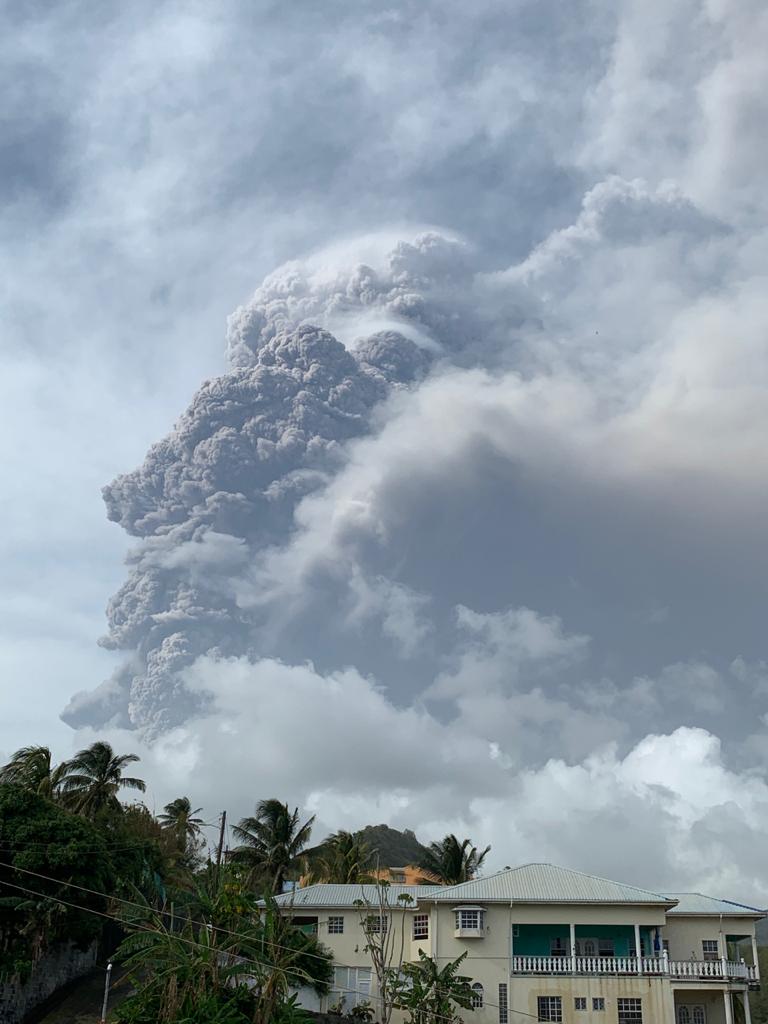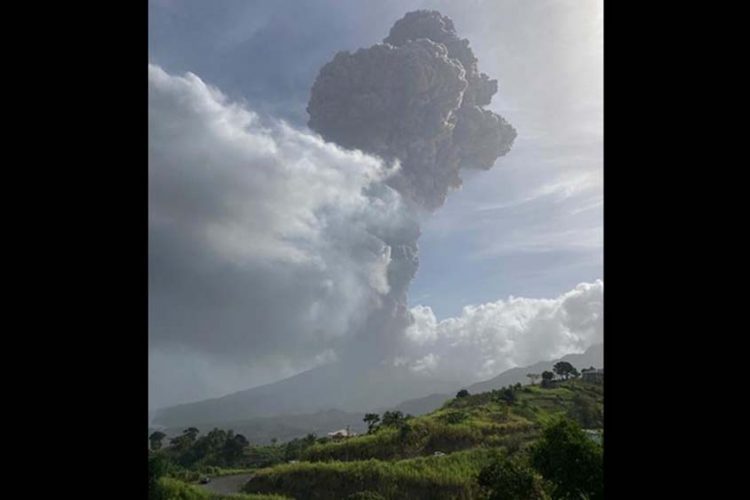ROSE HALL, St Vincent and the Grenadines, (Reuters) – La Soufriere volcano on the eastern Caribbean island ofSt. Vincent erupted today after decades of inactivity, sending dark plumes of ash and smoke billowing into the sky and forcing thousands from surrounding villages to evacuate.
Dormant since 1979, the volcano started showing signs of activity in December, spewing steam and smoke and rumbling away. That picked up this week, prompting Prime Minister of St. Vincent and the Grenadines Ralph Gonsalves to order an evacuation of the surrounding area late on Thursday.

Early today it finally erupted. Ash and smoke plunged the neighbouring area into near total darkness, blotting out the bright morning sun, said a Reuters witness, who reported hearing the explosion from Rose Hall, a nearby village.
Smaller explosions continued throughout the day, Erouscilla Joseph, director at the University of the West Indies Seismic Research Centre, told Reuters, adding that this kind of activity could go on for weeks if not months.
“This is just the beginning,” she said.
St. Vincent and the Grenadines, which has a population of just over 100,000, has not experienced volcanic activity since 1979, when an eruption created approximately $100 million in damages. An eruption by La Soufriere in 1902 killed more than 1,000 people. The name means “sulfur outlet” in French.
The eruption column was estimated to reach 10 km (6.2 miles) high, the seismic research centre said. Ash fall could affect the Grenadines, Barbados, St. Lucia and Grenada.
“The ash plume may cause flight delays due to diversions,” the centre said on Twitter. “On the ground, ash can cause discomfort in persons suffering with respiratory illnesses and will impact water resources.”
Local media have in recent days also reported increased activity from Mount Pelee on the island of Martinique, which lies to the north of St. Vincent beyond St. Lucia.
EVACUATIONS IN COVID ERA
Some 4,500 residents near the volcano had evacuated already via ships and by road, Gonsalves said at a news conference today. Heavy ash fall had halted the evacuation efforts somewhat due to poor visibility, according to St. Vincent’s National Emergency Management Organisation (NEMO).
“The place in general is in a frenzy,” said Lavern King, 28, a shelter volunteer. “People are still being evacuated from the red zone, it started yesterday evening and into last night.”
Gonsalves said that depending on the extent of the damage, it could be four months before evacuees could return home.
Welling up with tears, he said neighbouring islands such as Dominica, Grenada and Antigua had agreed to take evacuees in and cruise lines could ferry them over – as long as they got vaccinated first.
That though could prove a challenge, said opposition senator Shevern John, 42.
“People are very scared of the vaccine and they opt out of coming to a shelter because eventually they would have to adhere to the protocol,” she said. Shelters are also having to limit the number of evacuees they take due to COVID-19 protocols.
Vincentians would have to wait for further scientific analysis to know what steps to take next, she said.
“It can go for a few days or a few weeks,” she said. “At the moment, both ends of the island are covered in ash and very dark.”
————
With evacuees numbering over 20,000, the St Vincent Searchlight newspaper said that neighbouring islands, St. Lucia, Barbados, Grenada and Antigua have offered to house persons.
Also offering assistance in other areas like transportation and logistics are the United States Southern Command, Venezuela, Cuba and the Regional Security System (RSS), the report said.
PM Gonsalves said in a press briefing from Cabinet Room yesterday that he has been in touch with the Cuban authorities, the RSS and he has already spoken with Barbados’s Prime Minister Mia Mottley and St. Lucia’s Allen Chastanet.
During the press briefing ,he noted that Antigua and Grenada have also given a commitment that they will take Vincentians for a period of time, although he is not certain of the exact number of persons that will be evacuated.
Searchlight said that Grenada has offered a facility that can hold about 1800 persons, Antigua 500 (a hotel) and St. Lucia between 250 to 300. Persons are being housed at local shelters and in addition, the Royal Caribbean Cruise Line has offered one or more ships for transportation purposes to Barbados.
Gonsalves said that Professor Robertson projects that if the volcano erupts explosively, the country will have a period of about four months in which it will likely be in a condition of evacuation.
“Hopefully it would be a shorter period, but that is his estimate,” Gonsalves said while noting that persons who go to Barbados or St. Lucia will have to be vaccinated against the COVID-19 virus.
He said that St. Lucia will vaccinate persons when they arrive there, while the cruise line has indicated, through PM Mottley, that persons who will be on the cruise liner will also need to be vaccinated.
“We have also activated a contact which has been made to us by a cruise line to make available one or more cruise ships to hold persons, in addition to those who will be put in shelters,” Gonsalves said while noting that a lot of space is needed, and the process entails a lot of logistics to move people and house them.
“We can’t do the evacuation and the housing of persons in any slipshod manner. We have to do it in a proper way,” the PM said, according to Searchlight.





